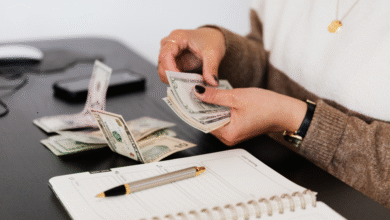How To Stop Living Paycheck To Paycheck

Look, I get it. That soul-crushing feeling when you check your bank account three days before payday and see $47 staring back at you? Yeah, been there, felt that panic.
Honestly, it sucks knowing that your next paycheck is already spoken for before it even hits your account.
Here’s the thing, though, you’re not alone in this mess.
Seriously, millions of people are riding this exhausting financial rollercoaster, and it’s not because they’re bad with money or lazy.
Sometimes life just has a way of keeping us stuck in survival mode.
But what if I told you that breaking free from this cycle isn’t about earning six figures or winning the lottery?
It’s about understanding some fundamental money principles that, frankly, nobody teaches us in school.
Trust me, as someone with a finance degree and years of watching people transform their financial lives.
I can tell you that small shifts create massive changes.
Ready to finally keep some cash in your pocket before payday rolls around? Let’s talk real solutions.
What Does Living Paycheck To Paycheck Mean?
Alright, let’s break this down in plain English. Living paycheck to paycheck means your entire salary vanishes before your next one arrives. Every. Single. Dollar.
You’re basically running on financial fumes, counting down the days until that direct deposit notification pops up on your phone.
And honestly? It’s exhausting.
Now, I’m not talking about the occasional tight month when your car decides to break down or your kid needs braces.
I’m talking about the chronic situation where there’s literally nothing left, no buffer, no cushion, no “oh crap” money for when life happens.
You pay your rent, cover utilities, buy groceries, maybe squeeze in a Netflix subscription (because let’s be real, we all need something), and boom, your bank account looks sadder than your motivation on a Monday morning.
The scary part? You’re one unexpected expense away from financial chaos.
That’s not sustainable, and deep down, you know it.
Why Am I Living Paycheck To Paycheck?
Here’s where it gets real. The main culprit isn’t necessarily that you don’t earn enough (though that can definitely be part of it).
More often than not, it’s about money mismanagement.
Before you get defensive, hear me out. Managing money effectively is a skill that nobody teaches us.
We’re expected to magically know how to handle finances just because we’re adults now.
Spoiler alert: That’s ridiculous.
Think about it this way, you wouldn’t expect someone to be a great cook without learning basic techniques, right?
The same goes for money. Without understanding fundamental financial principles, your hard-earned cash slips through your fingers like water.
I’ve seen people earning $100K still living paycheck to paycheck because they never learned to manage their money properly.
Meanwhile, others making $40K are building savings and investing for their future.
The difference? Financial literacy and intentional spending.
Sometimes it’s also about lifestyle creep. You get a raise, so you upgrade your apartment. You get a bonus, so you finance a nicer car.
Before you know it, your increased income is matched by increased expenses, and you’re back where you started, broke and stressed.
How Can I Stop Living Paycheck To Paycheck?
Good question! And honestly, the answer is simpler than you think (though simple doesn’t always mean easy, FYI).
You need to get crystal clear on the relationship between what’s coming in versus what’s going out.
I know, groundbreaking stuff, right? 🙂 But seriously, most people have no clue where their money actually goes.
Grab your bank statements from the last three months. Yeah, I know it sounds boring, but do it anyway.
Calculate your average monthly income and then list out every single expense.
I mean everything, from your mortgage to that random $3.99 app subscription you forgot about.
Here’s the truth bomb: if your expenses consistently exceed your income, no amount of budgeting tips will save you.
You’ve got a fundamental problem that requires either earning more or spending less (or ideally, both).
But if your income theoretically covers your expenses and you’re still broke? Then you’ve got a spending problem, my friend.
And that’s actually good news because spending is within your control.
You need to implement strategic financial habits that prevent your money from disappearing.
We’re talking budgets, tracking systems, and I know this sounds harsh, saying no to stuff you want but don’t need.
Negative Effects Of Living Paycheck To Paycheck
Let’s talk about why this cycle is genuinely dangerous for your financial future (and your mental health, honestly).
First up: debt spiral. When you have zero cushion and an emergency hit, because emergencies will hit, you’ve got no choice but to reach for that credit card.
Then you’re paying interest on top of your regular expenses, which makes everything worse.
It’s like quicksand; the more you struggle, the deeper you sink.
I’ve watched clients accumulate $20K, $30K, even $50K in credit card debt simply because they had no emergency buffer.
One car repair led to another unexpected expense, which led to another, and suddenly they’re drowning.
Second: financial stagnation. You’re stuck in place, unable to build any momentum toward your goals.
Want to buy a house? Can’t save for a down payment. Thinking about retirement?
Ha, that’s a luxury for “future you” to worry about. Dream of starting a business? Not happening when you’re stressed about making rent.
Your entire life gets put on hold because you’re trapped in survival mode. That’s not living, that’s just existing.
Third: stress and health impacts. The constant financial anxiety takes a serious toll.
You’re losing sleep, feeling anxious, and maybe even experiencing physical symptoms like headaches or stomach issues.
Money stress ruins relationships, affects job performance, and honestly just makes life miserable.
And here’s what really gets me: this cycle robs you of options.
Hate your job? Too bad, you can’t afford to leave. Want to relocate for better opportunities?
Can’t do it without savings. Your lack of a financial cushion becomes a cage.
Benefits Of Not Living Paycheck To Paycheck
Now let’s flip the script and talk about why breaking this cycle is absolutely worth the effort.
When you finally escape the paycheck-to-paycheck trap, you experience something revolutionary: breathing room.
You check your account mid-month, and there’s actually money there. Wild concept, I know.
But seriously, the benefits are life-changing:
You can actually plan for retirement. Instead of hoping Social Security will somehow cover your golden years.
(spoiler: it won’t), you’re contributing to a 401(k) or IRA. Compound interest becomes your friend instead of your enemy.
You build a real emergency fund. Car breaks down? Annoying, but not catastrophic.
Need an unexpected medical procedure? Stressful, but manageable.
You stop living in constant fear of the other shoe dropping because you’ve got a cushion to land on.
You avoid the debt trap. Without needing to rely on credit cards for every surprise expense, you stay out of high-interest debt.
This alone changes everything because you’re not throwing hundreds of dollars monthly at interest payments.
You can pay off existing debt faster. With better money management and extra breathing room, you can aggressively attack any debts you’ve already accumulated.
The psychological win of seeing those balances decrease is incredible.
You achieve financial stability. This might sound abstract, but it’s profound. You stop feeling like you’re constantly on thin ice, waiting to fall through.
You make decisions based on what’s best for you, not just what you can afford right now.
You gain options. Want to take a career risk? You can. Need to help family during a crisis?
You’re able to. See an amazing opportunity? You can jump on it. Financial flexibility creates life flexibility.
IMO, the biggest benefit is the mental and emotional freedom. The weight that lifts when you’re no longer stressed about money every single day? Priceless.
10 Tips To Help You Stop Living Paycheck To Paycheck
Alright, enough theory. Let’s get into the practical stuff that actually works.
1. Create A Budget

I can already hear you groaning. “Ugh, budgets are boring and restrictive!” Yeah, I used to think that too until I realised that budgets are actually permission slips for spending.
Think about it, a budget isn’t about deprivation; it’s about intentional allocation.
You’re telling your money where to go instead of wondering where it went. Huge difference.
When you create a budget, you’re essentially creating a spending plan that aligns with your priorities.
Want to save for vacation? Budget for it. Need new Tyres eventually? Budget for it. Enjoy your morning coffee run? Budget for it!
The magic happens when you see everything laid out clearly.
Suddenly, you notice that you’re spending $200 monthly on subscriptions you barely use, or $400 on eating out when you thought it was more like $150. Awareness is the first step to change.
I recommend the 50/30/20 rule as a starting framework: 50% for needs, 30% for wants, 20% for savings and debt repayment.
Adjust the percentages based on your situation, but the concept works brilliantly.
Use budgeting apps like Mint, YNAB (You Need A Budget), or even a simple spreadsheet.
The tool doesn’t matter as much as your commitment to tracking and sticking with it.
Real talk: your first budget will probably suck. You’ll underestimate some expenses and forget others entirely.
That’s totally normal. Adjust as you go and get better at it each month.
2. Build An Emergency Fund
This right here is your financial life jacket. An emergency fund is money you set aside specifically for unexpected expenses, not for vacations, not for holiday shopping, but for genuine emergencies.
Start with a goal of $1,000 as your starter emergency fund. Yeah, it won’t cover everything, but it’ll handle most minor crises: a broken phone, urgent car repair, or unexpected medical copay.
Once you’ve got that foundation, work toward 3-6 months of expenses. I know that sounds impossible right now, but remember, you’re not building it overnight.
Even $25 per paycheck adds up over time.
Here’s why this matters so much: without an emergency fund, every unexpected expense becomes a financial crisis.
You’re forced onto credit cards, which creates debt, which makes everything harder. It’s a vicious cycle.
But with an emergency fund? That car repair is annoying instead of devastating.
You handle it, move on, and rebuild the fund. No debt, no drama, no financial setback.
Keep your emergency fund in a high-yield savings account that’s separate from your regular checking.
You want it accessible but not too accessible.
Somewhere like Marcus by Goldman Sachs or Ally Bank works great.
Pro tip: automate your emergency fund contributions.
Set up automatic transfers the day after payday so you’re “paying yourself first.” If you never see the money, you won’t miss it.
3. Don’t Incur Debt

Look, I’m not going to lecture you about never using credit cards or taking loans.
Sometimes debt is necessary, mortgages, student loans, and reasonable car loans; these can make sense strategically.
But there’s a massive difference between strategic debt and lifestyle debt.
Financing a car you need to get to work? Reasonable. Charging a vacation you can’t afford? That’s asking for trouble.
The problem with debt is that it steals from your future income. Every dollar you owe is a dollar you’ve already spent plus interest.
When you’re living paycheck to paycheck and also servicing debt, you’re basically running on a financial treadmill, working hard but going nowhere.
I’ve seen people with $30K in credit card debt paying $600+ monthly just in minimum payments.
That’s $600 that could be building wealth instead of enriching credit card companies. It’s brutal.
If you already have debt, make paying it off a priority.
Use strategies like the debt avalanche (paying off the highest interest first) or the debt snowball (paying off the smallest balance first).
Both work; choose the one that keeps you motivated.
And please, for the love of your financial future, stop adding to your debt.
If you can’t pay cash for it, you probably can’t afford it right now. I know that’s harsh, but it’s true.
4. Bring In More Money (Find A Side Hustle)
Sometimes the math just doesn’t work. Your expenses are reasonable, you’ve cut where you can, but your income simply isn’t enough.
In that case, you need to increase your earning potential. Side hustles are everywhere if you look for them.
Freelance writing, graphic design, virtual assistant work, tutoring, pet sitting, driving for rideshare services, delivering food, the gig economy is vast.
I started freelance consulting on the side while working my full-time job, and those extra few hundred dollars monthly made a massive difference.
It gave me breathing room to build savings and pay down debt faster.
The beauty of a side hustle is that it’s additional income on top of your regular salary.
You can funnel 100% of it toward financial goals since your regular paycheck covers living expenses.
Check out platforms like Upwork, Fiverr, TaskRabbit, or even local Facebook groups for opportunities.
Start small and scale up as you figure out what works.
Yes, you’ll be tired. Yes, you’ll sacrifice some free time. But you know what? It’s temporary.
Once you break the paycheck-to-paycheck cycle and build some financial momentum, you can reevaluate whether you still need the side hustle.
5. Live Below Your Means
This concept trips people up because they confuse it with living miserably.
Living below your means doesn’t mean depriving yourself of everything enjoyable; it means spending less than you earn and being strategic about your money.
If you earn $4,000 monthly, live like you earn $3,200. That gap creates room for savings, debt repayment, and breathing space.
You’re intentionally creating margin in your finances instead of operating at 100% capacity all the time.
This requires distinguishing between needs and wants. You need shelter, food, basic transportation, and utilities. You want the fancy apartment, restaurant meals, new car, and premium cable package.
I’m not saying never enjoy anything, that’s not sustainable.
But question your spending. Do you need five streaming services or would two cover most of what you watch? Do you need the newest smartphone or would last year’s model work fine?
The goal is to create a lifestyle you can maintain comfortably while still making financial progress.
That might mean a smaller apartment, cooking more meals at home, or driving your paid-off car for a few more years.
Living below your means gives you power. Power to save, invest, and build the life you actually want instead of constantly reacting to financial pressure.
6. Work Multiple Jobs

Now, I know this isn’t what you want to hear. Working multiple jobs sounds exhausting because, well, it is.
But sometimes it’s the necessary bridge between where you are and where you want to be.
Millions of people juggle multiple income streams, not because they love working 60-hour weeks, but because they’re determined to improve their financial situation.
It’s a short-term sacrifice for long-term stability.
The key is being strategic about it. Don’t just work random jobs for minimal pay.
Find opportunities that either pay well per hour or offer flexible scheduling that complements your main job.
Maybe you work full-time Monday through Friday and add weekend shifts at a retail store.
Or you pick up evening shifts driving for Uber. Or you do freelance work during lunch breaks and after dinner.
This isn’t forever. You’re not committing to working two or three jobs for the next 20 years.
You’re hustling hard for 6 months, a year, maybe 18 months to build your emergency fund, pay off debt, and create some financial breathing room.
Once you’ve stabilised your finances, you can drop the extra work and maintain your progress with just your primary income.
But getting out of the paycheck-to-paycheck cycle often requires an intense push first.
7. Cut Down On Your Expenses
Time for some tough love: if you’re living paycheck to paycheck, you probably have expenses that need trimming. Sorry, not sorry.
Start by categorizing your expenses into fixed (rent, insurance, loan payments) and variable (groceries, entertainment, dining out).
You might not be able to change fixed costs immediately, but variable expenses are where you have control.
Challenge every expense. That gym membership you haven’t used in three months? Cancel it and work out at home or outside.
The premium cable package, when you mostly watch Netflix. Downgrade. The daily $6 latte? Brew coffee at home and save $150+ monthly.
I’m not suggesting you live like a monk and eliminate all joy from life.
But most of us have budget leaks, small, recurring expenses that we don’t notice but add up significantly over time.
Subscriptions are the worst offenders. The average person has 4-5 subscriptions they forgot about or rarely use.
Go through your bank statements and cancel anything you’re not actively using and loving.
Look at your three biggest variable expenses and find ways to reduce each by even 15-20%.
If you spend $600 monthly on groceries, can you get it to $500 through meal planning and avoiding food waste?
If you spend $300 on entertainment, can you cut it to $250 by choosing free or low-cost activities more often?
These cuts don’t feel significant individually, but combined, they can free up $200-300 monthly.
That’s money you can redirect toward savings or debt repayment, creating real financial progress.
8. Plan For Big Purchases
Here’s a scenario I see constantly: someone finally gets their finances organised, builds a small emergency fund, then, boom, they blow it all on an unplanned major purchase. Back to square one.
Big purchases require planning and saving, not impulse decisions funded by debt or depleting your emergency fund.
Need a new laptop? Start a sinking fund and contribute monthly until you can pay cash.
Want to upgrade your phone? Same thing.
Think about major expenses you know are coming: holiday gifts, car registration, annual insurance premiums, and home repairs.
These aren’t surprises; they’re predictable expenses that require planning.
Create separate savings buckets for different goals. Many banks let you open multiple savings accounts.
Have one for emergencies, one for car maintenance, one for annual expenses, and one for fun stuff.
Automate contributions to each based on your priorities.
This approach eliminates the “emergency” from expected expenses.
When your car registration comes due, you’re not scrambling for $200; you’ve been setting aside $20 monthly, and the money’s ready.
The same goes for wants. See a beautiful piece of furniture you love?
Great! Create a savings goal for it and contribute weekly or monthly until you’ve saved enough.
The satisfaction of buying it with cash far exceeds the anxiety of seeing that credit card balance increase.
Planning major purchases keeps you in control of your finances instead of letting purchases control you.
9. Have A Meal Plan
Food is one of the biggest budget busters for most people. Between groceries, eating out, coffee runs, and random snacks, you could easily spend $1,000+ monthly without realizing it.
Meal planning changes the game. When you know what you’re eating for the week, you shop strategically, avoid waste, and eliminate the expensive question: “What should we have for dinner?”
Here’s how I do it: Sunday afternoon, I plan meals for Monday through Thursday (we have leftovers Friday, eat out Saturday, and do something easy Sunday).
I check what’s already in the pantry and fridge, make a grocery list based on planned meals, and shop once.
This simple system saves me probably $400-500 monthly compared to winging it and eating out constantly.
That’s real money that can go toward financial goals instead.
Meal planning also helps you eat healthier (bonus!) and reduces the stress of daily decision-making.
You’re not standing in front of the fridge at 7 pm wondering what to make.
You already know, and you have the ingredients.
Batch cooking is your friend, too. Make a big batch of chilli, lasagna, or stir-fry and eat it for several days.
Your future self will thank you when you’re tired and tempted to order takeout, but you have a delicious homemade meal ready to heat up.
Apps like Mealime or Paprika make meal planning easier. Or just use a simple note on your phone. The tool doesn’t matter, the habit does.
10. Focus On Your Needs
Last but definitely not least: prioritise needs over wants. This is fundamental to breaking the paycheck-to-paycheck cycle, but it’s also where people struggle most.
We live in a consumer culture that constantly tells us we need the latest gadgets, trendy clothes, new furniture, and fancy experiences.
But the truth? Most of that is wants masquerading as needs.
Your actual needs are pretty basic: shelter, food, basic clothing, transportation, utilities, and healthcare.
Everything else falls into the “want” category, and there’s nothing wrong with wants, as long as they don’t sabotage your financial stability.
When you’re trying to escape the paycheck-to-paycheck cycle, your needs get priority funding. Period.
Once needs are covered and you’ve funded savings and debt repayment, then you can spend on wants.
This requires honesty with yourself. Do you need the $200 name-brand shoes, or do you want them, while the $60 shoes would work fine?
Do you need to upgrade your perfectly functional TV, or do you want a bigger one?
Do you need another streaming service, or do you want more content options when you already have plenty?
I get it, saying no to things you want sucks. But you know what sucks more?
Living in constant financial stress, unable to handle emergencies, working paycheck to paycheck with no end in sight.
The beautiful thing is that this focus on needs is temporary. Once you’ve built financial stability, you can absolutely spend on wants without guilt or anxiety.
But you’ve got to build that foundation first.
Final Thoughts
Breaking free from the paycheck-to-paycheck cycle isn’t about a huge salary or instant wealth.
It’s about mastering timeless money principles that work at any income level: spend less than you earn, track every dollar, build an emergency fund, and avoid debt that drains your future.
Simple ideas, but they demand consistency and self-control.
Start small: make a budget, save even $20 per paycheck, and cut unnecessary expenses.
Increase your income where possible and plan your spending instead of buying on impulse.
These habits work; I’ve seen people go from broke to financially secure with steady effort and discipline.
It won’t be easy or fast, but it’ll be worth it when you finally see money left in your account mid-month.
Take it one choice, one dollar at a time. Your financial freedom starts with today’s action.
Now go make that budget, yes, right now.








